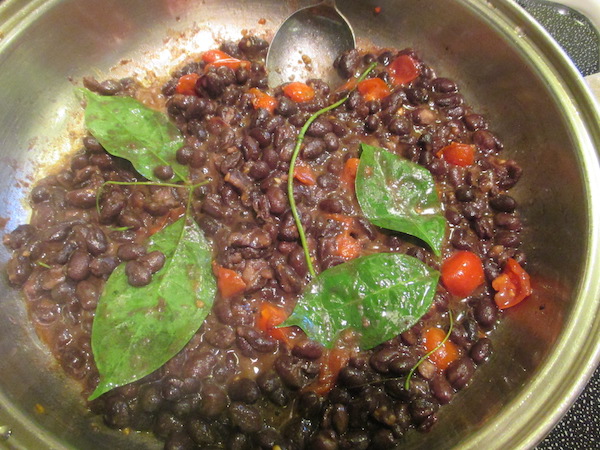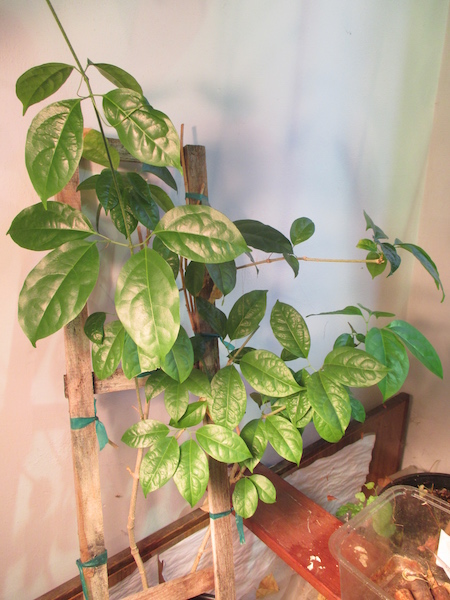| In April 2010, I bought, by mail order from Florida, a Garlic Vine, to grow in a pot as a houseplant in Seattle. It appealed to me to be able to get a garlic substitute year-round. This article details what I have learned about it and its relatives. Much of the data is from a 2010 Botany PhD thesis (in Portuguese) written by Milene Maria da Silva-Castro. Maybe after I read a more recent (2014) article in a scholarly journal, some of the scientific names cited herein will change. If --unlike me-- you have access, you can check the article yourself: A new generic classification of tribe Bignonieae (Bignoniaceae) in the Annals of the Missouri Botanical Garden vol. 99: pages 348 - 489 (2014). |
| Without checking the article, then, the genus Mansoa consists of 17 species of vines in tropical Central and South America, mostly Brazilian. Most but not all Mansoa species feature garlic-scented foliage (or onion-scented), including the two Garlic Vines I single out this month. A Spanish name is ajo sacha (false garlic), Portuguese is cipó-de-alho (garlic vine). |
There are some vines both in Mansoa and related genera that look superficially alike, and may get called Garlic Vine, but lack the garlic smell. For example:
|
| Bignonia æquinoctialis L. |
| = Cydista æquinoctialis (L.) Miers |
(Garlic Vine. Equinox Vine)
|
| Bignonia callistegioides Cham. |
| = Clytostoma callistegioides (Cham.) Baill. |
(Violet Trumpet-Vine)
|
Getting genera and species sorted correctly matters because while some garlic vines are used as garlic-substitute condiments, as well as medicinally, some similar-looking vines can be harmful if ingested. For example, Mansoa verrucifera (Schlect.) A. Gentry is toxic to livestock, producing convulsions in them. In general, Garlic Vines are cultivated for three possible motives: 1) ornamental flowers; 2) medicinal usages; or 3) culinary use.
|
| Garlic Vine. Ajo Sacha |
Mansoa alliacea (Lam. ) A. Gentry
|
| = Adenocalymma alliacea (Lam.) Miers. |
| = Pseudocalymma alliacea (Lam.) Sandw. |
| = Pachyptera alliacea (Lam.) A. Gentry |
| Not known in USA cultivation as of 1993. But its name has been, is being, and will be misapplied often by nurseries to Mansoa Hymenæa. It is used as a condiment in its native area, and is cultivated there, even commercially. |
Native to Puerto Rico and South America: Brazil (Amazonas, Pará and Maranhão), Bolivia, Colombia, Ecuador, Guyana, French Guiana, Peru and Venezuela. Compared to Mansoa Hymenæa, it is seldom cultivated outside its native range; has relatively long and slender leaflets (up to 26.5 cm. long by 10 cm. wide); longer but narrow flowers (6.7 to 9.2 cm. long by 2-2.5 cm. wide); and squat seedpods (about 8.5 cm. long by 2.9 cm. wide).
|
| Garlic Vine. Ajo Sacha Macha |
| Mansoa Hymenæa (A. DC.) A. Gentry |
| = Pseudocalymma alliacea auct., non (Lam.) Sandw. |
| = Pachyptera Hymenæa (A. DC.) A. Gentry |
| In the wild, known only in E Brazil --Bahia, Espírito Santo and Rio de Janeiro. Cultivated widely around the tropics; in USA cultivation often if not usually misidentified as Mansoa alliacea. The two species are in fact not related closely. But they are used the same way. |
| Compared to Mansoa alliacea, it very widely cultivated outside its native range; has relatively short and broad leaflets (up to 18 cm. long by 11 cm. wide); shorter but wider flowers (6.5 to 7 cm. long by 4-5 cm. wide); its flowers can be white, lavender or magenta; and elongated seedpods (about 29-31 cm. long by 2-2.5 cm. wide). |
Some plants in Mexico, Central America and the Amazon forest previously called Mansoa Hymenæa differ enough from Mansoa Hymenæa of the Brazilian Atlantic forest that the former are now called Mansoa Sagotii (Bureau & K. Schum.) M.M. Silva-Castro & L.P. Queiroz 2014. It has more of a chive or green onion smell. I have no idea if it is cultivated outside its native area. If so, it would be under another name than Mansoa Sagotii.
|
My vine was sold as Mansoa alliacea but is really Mansoa Hymenæa. It has not bloomed yet. The photographs show its foliage.
Back |

Mansoa hymenæa. used to flavor black beans & tomatoes; photo by ALJ
|

Mansoa hymenæa. as a houseplant; photo by ALJ
|

